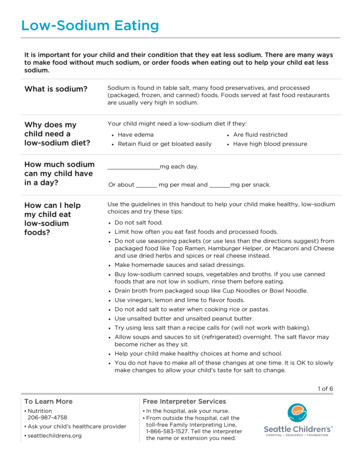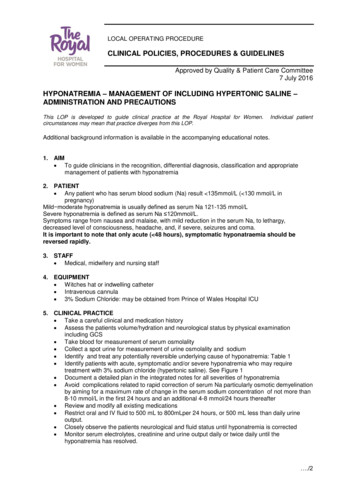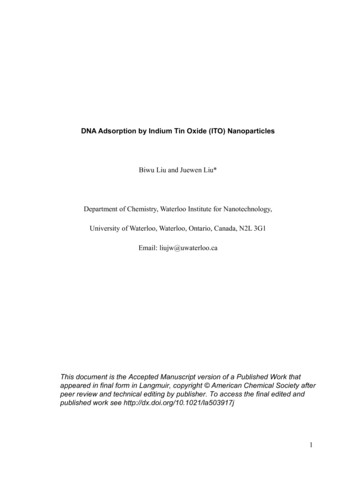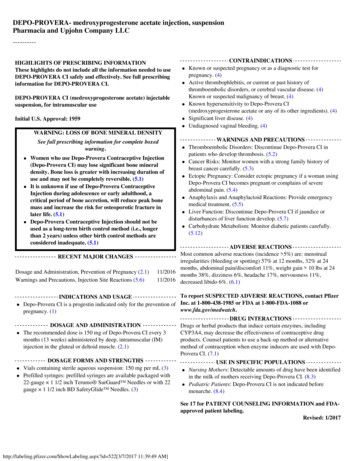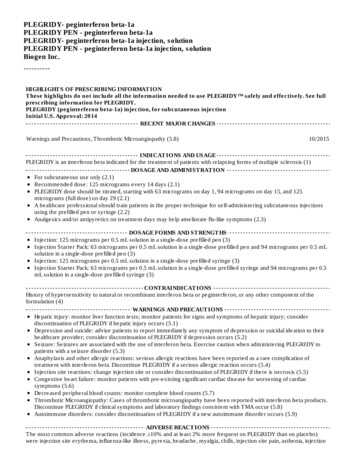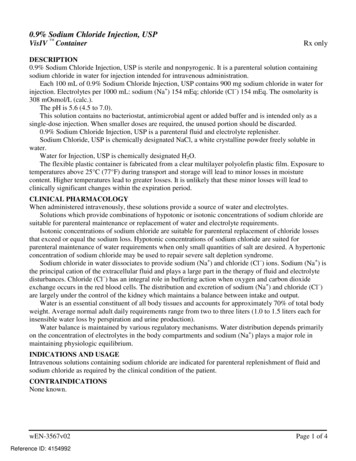
Transcription
0.9% Sodium Chloride Injection, USPVisIV ContainerRx onlyDESCRIPTION0.9% Sodium Chloride Injection, USP is sterile and nonpyrogenic. It is a parenteral solution containingsodium chloride in water for injection intended for intravenous administration.Each 100 mL of 0.9% Sodium Chloride Injection, USP contains 900 mg sodium chloride in water forinjection. Electrolytes per 1000 mL: sodium (Na ) 154 mEq; chloride (Cl–) 154 mEq. The osmolarity is308 mOsmol/L (calc.).The pH is 5.6 (4.5 to 7.0).This solution contains no bacteriostat, antimicrobial agent or added buffer and is intended only as asingle-dose injection. When smaller doses are required, the unused portion should be discarded.0.9% Sodium Chloride Injection, USP is a parenteral fluid and electrolyte replenisher.Sodium Chloride, USP is chemically designated NaCl, a white crystalline powder freely soluble inwater.Water for Injection, USP is chemically designated H2O.The flexible plastic container is fabricated from a clear multilayer polyolefin plastic film. Exposure totemperatures above 25 C (77 F) during transport and storage will lead to minor losses in moisturecontent. Higher temperatures lead to greater losses. It is unlikely that these minor losses will lead toclinically significant changes within the expiration period.CLINICAL PHARMACOLOGYWhen administered intravenously, these solutions provide a source of water and electrolytes.Solutions which provide combinations of hypotonic or isotonic concentrations of sodium chloride aresuitable for parenteral maintenance or replacement of water and electrolyte requirements.Isotonic concentrations of sodium chloride are suitable for parenteral replacement of chloride lossesthat exceed or equal the sodium loss. Hypotonic concentrations of sodium chloride are suited forparenteral maintenance of water requirements when only small quantities of salt are desired. A hypertonicconcentration of sodium chloride may be used to repair severe salt depletion syndrome.Sodium chloride in water dissociates to provide sodium (Na ) and chloride (Cl–) ions. Sodium (Na ) isthe principal cation of the extracellular fluid and plays a large part in the therapy of fluid and electrolytedisturbances. Chloride (Cl–) has an integral role in buffering action when oxygen and carbon dioxideexchange occurs in the red blood cells. The distribution and excretion of sodium (Na ) and chloride (Cl–)are largely under the control of the kidney which maintains a balance between intake and output.Water is an essential constituent of all body tissues and accounts for approximately 70% of total bodyweight. Average normal adult daily requirements range from two to three liters (1.0 to 1.5 liters each forinsensible water loss by perspiration and urine production).Water balance is maintained by various regulatory mechanisms. Water distribution depends primarilyon the concentration of electrolytes in the body compartments and sodium (Na ) plays a major role inmaintaining physiologic equilibrium.INDICATIONS AND USAGEIntravenous solutions containing sodium chloride are indicated for parenteral replenishment of fluid andsodium chloride as required by the clinical condition of the patient.CONTRAINDICATIONSNone known.wEN-3567v02Reference ID: 4154992Page 1 of 4
WARNINGSSodium Chloride Injection, USP should be used with great care, if at all, in patients with congestive heartfailure, severe renal insufficiency and in clinical states in which there exists edema with sodium retention.The intravenous administration of Sodium Chloride Injection, USP can cause fluid and/or soluteoverloading resulting in dilution of serum electrolyte concentrations, overhydration, congested states orpulmonary edema.The risk of dilutive states is inversely proportional to the electrolyte concentration of the injections.The risk of solute overload causing congested states with peripheral and pulmonary edema is directlyproportional to the electrolyte concentrations of the injections.In patients with diminished renal function, administration of Sodium Chloride Injection, USP mayresult in sodium retention.PRECAUTIONSGeneralDo not use plastic containers in series connections. Such use could result in air embolism due to residualair being drawn from the primary container before administration of the fluid from the secondarycontainer is completed.Pressurizing intravenous solutions contained in flexible plastic containers to increase flow rates canresult in air embolism if the residual air in the container is not fully evacuated prior to administration.Use of a vented intravenous administration set with the vent in the open position could result in airembolism. Vented intravenous administration sets with the vent in the open position should not be usedwith flexible plastic containers.Laboratory TestsClinical evaluation and periodic laboratory determinations are necessary to monitor changes in fluidbalance, electrolyte concentrations and acid-base balance during prolonged parenteral therapy orwhenever the condition of the patient warrants such evaluation.DRUG INTERACTIONSCaution must be exercised in the administration of Sodium Chloride Injection, USP, to patients receivingcorticosteroids or corticotropin.Carcinogenesis, Mutagenesis, Impairment of FertilityStudies have not been performed with Sodium Chloride Injection, USP to evaluate the potential forcarcinogenesis, mutagenesis or impairment of fertility.Pregnancy:Teratogenic EffectsPregnancy Category CAnimal reproduction studies have not been conducted with sodium chloride. It is also not known whethersodium chloride can cause fetal harm when administered to a pregnant woman or can affect reproductioncapacity. Sodium chloride should be given to a pregnant woman only if clearly needed.Labor and DeliveryStudies have not been conducted to evaluate the effects of Sodium Chloride Injection, USP on labor anddelivery. Caution should be exercised when administering this drug during labor and delivery.Nursing MothersIt is not known whether this drug is excreted in human milk. Because many drugs are excreted in humanmilk, caution should be exercised when Sodium Chloride Injection, USP is administered to a nursingmother.wEN-3567v02Reference ID: 4154992Page 2 of 4
Pediatric UseThe use of Sodium Chloride Injection, USP in pediatric patients is based on clinical practice. Plasmaelectrolyte concentrations should be closely monitored in the pediatric population as this population mayhave impaired ability to regulate fluids and electrolytes.Geriatric UseClinical studies of Sodium Chloride Injection, USP did not include sufficient numbers of subjects aged 65and over to determine whether they respond differently from younger subjects. Other reported clinicalexperience has not identified differences in responses between elderly and younger patients. In general,dose selection for an elderly patient should be cautious, usually starting at the low end of the dosingrange, reflecting the greater frequency of decreased hepatic, renal, or cardiac function, and of concomitantdisease or drug therapy.This drug is known to be substantially excreted by the kidney, and the risk of toxic reactions to thisdrug may be greater in patients with impaired renal function. Because elderly patients are more likely tohave decreased renal function, care should be taken in dose selection, and it may be useful to monitorrenal function.Do not administer unless solution is clear and container is undamaged. Discard unused portion.ADVERSE REACTIONSReactions which may occur because of the solution or the technique of administration include febrileresponse, infection at the site of injection, venous thrombosis or phlebitis extending from the site ofinjection, extravasation and hypervolemia.If an adverse reaction does occur, discontinue the infusion, evaluate the patient, institute appropriatetherapeutic countermeasures and save the remainder of the fluid for examination if deemed necessary.OVERDOSAGEIn the event of overhydration or solute overload, re-evaluate the patient and institute appropriatecorrective measures. (See WARNINGS, PRECAUTIONS, and ADVERSE REACTIONS).DOSAGE AND ADMINISTRATIONThe dose is dependent upon the age, weight and clinical condition of the patient.Additives may be incompatible. Consult with pharmacist, if available. When introducing additives,use aseptic technique, mix thoroughly and do not store.Parenteral drug products should be inspected visually for particulate matter and discoloration prior toadministration, whenever solution and container permit. (See PRECAUTIONS).INSTRUCTIONS FOR USECheck for leaks by squeezing container firmly. If leaks are found, discard unit as sterility may beimpaired. If supplemental medication is desired, follow directions below before preparing foradministration.To Add Medication(Use aseptic technique)1. Remove blue cap from BLU-MED sterile medication additive port at bottom of container.2. With a needle of appropriate length, puncture resealable additive port and inject. Withdraw needleafter injecting medication.3. Mix container contents thoroughly.4. The additive port may be protected by an appropriate cover.wEN-3567v02Reference ID: 4154992Page 3 of 4
Preparation for Administration(Use aseptic technique)NOTE: See appropriate IV administration set Instructions for Use.1. Close flow control clamp of administration set.2. Remove cap from sterile administration set port at bottom of container.3. Insert piercing pin of administration set into port with a twisting motion until the pin is firmlyseated.4. Suspend container.5. Squeeze and release drip chamber to establish proper fluid level in chamber.6. Open clamp. Eliminate air from remainder of set.7. Attach set to patient access device.8. Begin infusion.WARNING: Do not use flexible container in series connections.HOW SUPPLIED0.9% Sodium Chloride Injection, USP is supplied in single-dose flexible plastic containers as follows:NDC No.0409-7983-250409-7983-300409-7983-48Product Name0.9% Sodium ChlorideInjection, USP0.9% Sodium ChlorideInjection, USP0.9% Sodium ChlorideInjection, USPFill Volume/Container Size (mL)250/250500/5001000/1000Store at 20 to 25 C (68 to 77 F). [See USP Controlled Room Temperature.] Protect from freezing.Revised: 6/2014EN-3567Hospira, Inc., Lake Forest, IL 60045 USAwEN-3567v02Reference ID: 4154992Page 4 of 4
Sodium Chloride Injection, USPVisIV ContainerRx onlyDESCRIPTIONSodium Chloride Injection, USP solutions are sterile and nonpyrogenic. They are parenteral solutionscontaining various concentrations of sodium chloride in water for injection intended for intravenousadministration.For 0.45% Sodium Chloride Injection, USP, each 100 mL contains 450 mg sodium chloride in waterfor injection. Electrolytes per 1000 mL: sodium 77 mEq; chloride 77 mEq. The osmolarity is154 mOsmol/L (calc.).For 0.9% Sodium Chloride Injection, USP, each 100 mL contains 900 mg sodium chloride in waterfor injection. Electrolytes per 1000 mL: sodium 154 mEq; chloride 154 mEq. The osmolarity is308 mOsmol/L (calc.).The pH for both concentrations in the 100 mL and smaller containers is 6.0; for the 250 mL and largercontainers, the pH is 5.6. The pH range is 4.5 to 7.0 for all containers.The solutions contain no bacteriostat, antimicrobial agent or added buffer and each is intended only asa single-dose injection. When smaller doses are required the unused portion should be discarded.The solutions are parenteral fluid and electrolyte replenishers.Sodium Chloride, USP is chemically designated NaCl, a white crystalline powder freely soluble inwater.Water for Injection, USP is chemically designated H2O.The flexible plastic container is fabricated from a clear multilayer polyolefin plastic film. Exposure totemperatures above 25 C (77 F) during transport and storage will lead to minor losses in moisturecontent. Higher temperatures lead to greater losses. It is unlikely that these minor losses will lead toclinically significant changes within the expiration period.CLINICAL PHARMACOLOGYWhen administered intravenously, these solutions provide a source of water and electrolytes.Solutions which provide combinations of hypotonic or isotonic concentrations of sodium chloride aresuitable for parenteral maintenance or replacement of water and electrolyte requirements.Isotonic concentrations of sodium chloride are suitable for parenteral replacement of chloride lossesthat exceed or equal the sodium loss. Hypotonic concentrations of sodium chloride are suited forparenteral maintenance of water requirements when only small quantities of salt are desired. A hypertonicconcentration of sodium chloride may be used to repair severe salt depletion syndrome.Sodium chloride in water dissociates to provide sodium (Na ) and chloride (Cl–) ions. Sodium (Na ) isthe principal cation of the extracellular fluid and plays a large part in the therapy of fluid and electrolytedisturbances. Chloride (Cl–) has an integral role in buffering action when oxygen and carbon dioxideexchange occurs in the red blood cells. The distribution and excretion of sodium (Na ) and chloride (Cl–)are largely under the control of the kidney which maintains a balance between intake and output.Water is an essential constituent of all body tissues and accounts for approximately70% of total body weight. Average normal adult daily requirements range from two to three liters (1.0 to1.5 liters each for insensible water loss by perspiration and urine production).Water balance is maintained by various regulatory mechanisms. Water distribution depends primarilyon the concentration of electrolytes in the body compartments and sodium (Na ) plays a major role inmaintaining physiologic equilibrium.INDICATIONS AND USAGEIntravenous solutions containing sodium chloride are indicated for parenteral replenishment of fluid andsodium chloride as required by the clinical condition of the patient.wEN-3568v02Reference ID: 4154992Page 1 of 4
CONTRAINDICATIONSNone known.WARNINGSSodium Chloride Injection, USP should be used with great care, if at all, in patients with congestive heartfailure, severe renal insufficiency and in clinical states in which there exists edema with sodium retention.The intravenous administration of Sodium Chloride Injection, USP can cause fluid and/or soluteoverloading resulting in dilution of serum electrolyte concentrations, overhydration, congested states orpulmonary edema.The risk of dilutive states is inversely proportional to the electrolyte concentration of the injections.The risk of solute overload causing congested states with peripheral and pulmonary edema is directlyproportional to the electrolyte concentrations of the injections.In patients with diminished renal function, administration of Sodium Chloride Injection, USP mayresult in sodium retention.PRECAUTIONSGeneralDo not use plastic containers in series connections. Such use could result in air embolism due to residualair being drawn from the primary container before administration of the fluid from the secondarycontainer is completed.Pressurizing intravenous solutions contained in flexible plastic containers to increase flow rates canresult in air embolism if the residual air in the container is not fully evacuated prior to administration.Use of a vented intravenous administration set with the vent in the open position could result in airembolism. Vented intravenous administration sets with the vent in the open position should not be usedwith flexible plastic containers.Laboratory TestsClinical evaluation and periodic laboratory determinations are necessary to monitor changes in fluidbalance, electrolyte concentrations and acid-base balance during prolonged parenteral therapy orwhenever the condition of the patient warrants such evaluation.DRUG INTERACTIONSCaution must be exercised in the administration of Sodium Chloride Injection, USP, to patients receivingcorticosteroids or corticotropin.Carcinogenesis, Mutagenesis, Impairment of FertilityStudies have not been performed with Sodium Chloride Injection, USP to evaluate the potential forcarcinogenesis, mutagenesis or impairment of fertility.Pregnancy:Teratogenic EffectsPregnancy Category CAnimal reproduction studies have not been conducted with sodium chloride. It is also not known whethersodium chloride can cause fetal harm when administered to a pregnant woman or can affect reproductioncapacity. Sodium chloride should be given to a pregnant woman only if clearly needed.Nursing MothersIt is not known whether this drug is excreted in human milk. Because many drugs are excreted in humanmilk, caution should be exercised when Sodium Chloride Injection, USP is administered to a nursingmother.wEN-3568v02Reference ID: 4154992Page 2 of 4
Pediatric UseThe use of Sodium Chloride Injection, USP in pediatric patients is based on clinical practice.Plasma electrolyte concentrations should be closely monitored in the pediatric population as thispopulation may have impaired ability to regulate fluids and electrolytes.The infusion of hypotonic fluids (0.45% Sodium Chloride Injection, USP) together with thenon-osmotic secretion of ADH may result in hyponatremia in patients with acute volume depletion.Hyponatremia can lead to headache, nausea, seizures, lethargy, coma, cerebral edema and death, thereforeacute symptomatic hyponatremic encephalopathy is considered a medical emergency.Geriatric UseClinical studies of Sodium Chloride Injection, USP did not include sufficient numbers of subjects aged 65and over to determine whether they respond differently from younger subjects. Other reported clinicalexperience has not identified differences in responses between elderly and younger patients. In general,dose selection for an elderly patient should be cautious, usually starting at the low end of the dosingrange, reflecting the greater frequency of decreased hepatic, renal, or cardiac function, and of concomitantdisease or drug therapy.This drug is known to be substantially excreted by the kidney, and the risk of toxic reactions to thisdrug may be greater in patients with impaired renal function. Because elderly patients are more likely tohave decreased renal function, care should be taken in dose selection, and it may be useful to monitorrenal function.Do not administer unless solution is clear and container is undamaged. Discard unused portion.ADVERSE REACTIONSReactions which may occur because of the solution or the technique of administration include febrileresponse, infection at the site of injection, venous thrombosis or phlebitis extending from the site ofinjection, extravasation and hypervolemia.If an adverse reaction does occur, discontinue the infusion, evaluate the patient, institute appropriatetherapeutic countermeasures and save the remainder of the fluid for examination if deemed necessary.In addition to the above listed adverse reactions hyponatremia has been reported for 0.45% SodiumChloride Injection, USP (see Pediatric Use section).OVERDOSAGEIn the event of overhydration or solute overload, re-evaluate the patient and institute appropriatecorrective measures. (See WARNINGS, PRECAUTIONS, and ADVERSE REACTIONS.)DOSAGE AND ADMINISTRATIONThe dose is dependent upon the age, weight and clinical condition of the patient.Additives may be incompatible. Consult with pharmacist, if available. When introducing additives,use aseptic technique, mix thoroughly and do not store.Parenteral drug products should be inspected visually for particulate matter and discoloration prior toadministration, whenever solution and container permit. (See PRECAUTIONS.)INSTRUCTIONS FOR USECheck for leaks by squeezing container firmly. If leaks are found, discard unit as sterility may beimpaired. If supplemental medication is desired, follow directions below before preparing foradministration.wEN-3568v02Reference ID: 4154992Page 3 of 4
To Add Medication(Use aseptic technique)1. Remove blue cap from BLU-MED sterile medication additive port at bottom of container.2. With a needle of appropriate length, puncture resealable additive port and inject. Withdraw needleafter injecting medication.3. Mix container contents thoroughly.4. The additive port may be protected by an appropriate cover.Preparation for Administration(Use aseptic technique)NOTE: See appropriate IV administration set Instructions for Use.1. Close flow control clamp of administration set.2. Remove cap from sterile administration set port at bottom of container.3. Insert piercing pin of administration set into port with a twisting motion until the pin is firmlyseated.4. Suspend container.5. Squeeze and release drip chamber to establish proper fluid level in chamber.6. Open clamp. Eliminate air from remainder of set.7. Attach set to patient access device.8. Begin infusion.WARNING: Do not use flexible container in series connections.HOW SUPPLIEDSodium Chloride Injection, USP is supplied in single-dose flexible plastic containers in various sizes andconcentrations as shown in the accompanying Table.Fill Volume/NDC No.ProductContainer size mL0409-7730-060.45% Sodium Chloride Inj., USP50/500409-7730-110.45% Sodium Chloride Inj., USP100/1000409-7984-060.9% Sodium Chloride Inj., USP50/500409-7984-110.9% Sodium Chloride Inj., USP100/100Store at 20 to 25 C (68 to 77 F). [See USP Controlled Room Temperature.] Protect from freezing.Revised: 6/2014EN-3568Hospira, Inc., Lake Forest, IL 60045 USAwEN-3568v02Reference ID: 4154992Page 4 of 4
Sodium Chloride Injection, USPFlexible Plastic ContainerRx onlyDESCRIPTIONSodium Chloride Injection, USP solutions are sterile and nonpyrogenic. They are parenteral solutionscontaining various concentrations of sodium chloride in water for injection intended for intravenousadministration.For 0.45% Sodium Chloride Injection, USP, each 100 mL contains 450 mg sodium chloride in waterfor injection. Electrolytes per 1000 mL: sodium 77 mEq; chloride 77 mEq. The osmolarity is154 mOsmol/L (calc.).For 0.9% Sodium Chloride Injection, USP, each 100 mL contains 900 mg sodium chloride in waterfor injection. Electrolytes per 1000 mL: sodium 154 mEq; chloride 154 mEq. The osmolarity is308 mOsmol/L (calc.).The pH for both concentrations in the 100 mL and smaller containers is 6.0; for the 250 mL and largercontainers, the pH is 5.6. The pH range is 4.5 to 7.0 for all containers.The solutions contain no bacteriostat, antimicrobial agent or added buffer and each is intended only asa single-dose injection. When smaller doses are required the unused portion should be discarded.The solutions are parenteral fluid and electrolyte replenishers.Sodium Chloride, USP is chemically designated NaCl, a white crystalline powder freely soluble inwater.Water for Injection, USP is chemically designated H2O.The flexible plastic container is fabricated from a specially formulated polyvinylchloride. Water canpermeate from inside the container into the overwrap but not in amounts sufficient to affect the solutionsignificantly. Solutions in contact with the plastic container may leach out certain chemical componentsfrom the plastic in very small amounts; however, biological testing was supportive of the safety of theplastic container materials. Exposure to temperatures above 25 C (77 F) during transport and storage willlead to minor losses in moisture content. Higher temperatures lead to greater losses. It is unlikely thatthese minor losses will lead to clinically significant changes within the expiration period.CLINICAL PHARMACOLOGYWhen administered intravenously, these solutions provide a source of water and electrolytes.Solutions which provide combinations of hypotonic or isotonic concentrations of sodium chloride aresuitable for parenteral maintenance or replacement of water and electrolyte requirements.Isotonic concentrations of sodium chloride are suitable for parenteral replacement of chloride lossesthat exceed or equal the sodium loss. Hypotonic concentrations of sodium chloride are suited forparenteral maintenance of water requirements when only small quantities of salt are desired. A hypertonicconcentration of sodium chloride may be used to repair severe salt depletion syndrome.Sodium chloride in water dissociates to provide sodium (Na ) and chloride (Cl–) ions. Sodium (Na ) isthe principal cation of the extracellular fluid and plays a large part in the therapy of fluid and electrolytedisturbances. Chloride (Cl–) has an integral role in buffering action when oxygen and carbon dioxideexchange occurs in the red blood cells. The distribution and excretion of sodium (Na ) and chloride (Cl–)are largely under the control of the kidney which maintains a balance between intake and output.Water is an essential constituent of all body tissues and accounts for approximately 70% of total bodyweight. Average normal adult daily requirements range from two to three liters (1.0 to 1.5 liters each forinsensible water loss by perspiration and urine production).Water balance is maintained by various regulatory mechanisms. Water distribution depends primarilyon the concentration of electrolytes in the body compartments and sodium (Na ) plays a major role inmaintaining physiologic equilibrium.wEN-3569v02Reference ID: 4154992Page 1 of 5
INDICATIONS AND USAGEIntravenous solutions containing sodium chloride are indicated for parenteral replenishment of fluid andsodium chloride as required by the clinical condition of the patient.CONTRAINDICATIONSNone known.WARNINGSSodium Chloride Injection, USP should be used with great care, if at all, in patients with congestive heartfailure, severe renal insufficiency and in clinical states in which there exists edema with sodium retention.The intravenous administration of Sodium Chloride Injection, USP can cause fluid and/or soluteoverloading resulting in dilution of serum electrolyte concentrations, overhydration, congested states orpulmonary edema.The risk of dilutive states is inversely proportional to the electrolyte concentration of the injections.The risk of solute overload causing congested states with peripheral and pulmonary edema is directlyproportional to the electrolyte concentrations of the injections.In patients with diminished renal function, administration of Sodium Chloride Injection, USP mayresult in sodium retention.PRECAUTIONSGeneralDo not use plastic containers in series connections. Such use could result in air embolism due to residualair being drawn from the primary container before administration of the fluid from the secondarycontainer is completed.Pressurizing intravenous solutions contained in flexible plastic containers to increase flow rates canresult in air embolism if the residual air in the container is not fully evacuated prior to administration.Use of a vented intravenous administration set with the vent in the open position could result in airembolism. Vented intravenous administration sets with the vent in the open position should not be usedwith flexible plastic containers.Laboratory TestsClinical evaluation and periodic laboratory determinations are necessary to monitor changes in fluidbalance, electrolyte concentrations and acid-base balance during prolonged parenteral therapy orwhenever the condition of the patient warrants such evaluation.DRUG INTERACTIONSCaution must be exercised in the administration of Sodium Chloride Injection, USP to patients receivingcorticosteroids or corticotropin.Carcinogenesis, Mutagenesis, Impairment of FertilityStudies have not been performed with Sodium Chloride Injection, USP to evaluate the potential forcarcinogenesis, mutagenesis or impairment of fertility.Pregnancy:Teratogenic EffectsPregnancy Category CAnimal reproduction studies have not been conducted with Sodium Chloride Injection, USP. It is also notknown whether Sodium Chloride Injection, USP can cause fetal harm when administered to a pregnantwoman or can affect reproduction capacity. Sodium Chloride Injection, USP should be given to apregnant woman only if clearly needed.wEN-3569v02Reference ID: 4154992Page 2 of 5
Labor and DeliveryStudies have not been conducted to evaluate the effects of Sodium Chloride Injection, USP on labor anddelivery. Caution should be exercised when administering this drug during labor and delivery.Nursing MothersIt is not known whether this drug is excreted in human milk. Because many drugs are excreted in humanmilk, caution should be exercised when Sodium Chloride Injection, USP is administered to a nursingmother.Pediatric UseThe use of Sodium Chloride Injection, USP in pediatric patients is based on clinical practice.Plasma electrolyte concentrations should be closely monitored in the pediatric population as thispopulation may have impaired ability to regulate fluids and electrolytes.The infusion of hypotonic fluids (0.45% Sodium Chloride Injection, USP) together with the nonosmotic secretion of ADH may result in hyponatremia in patients with acute volume depletion.Hyponatremia can lead to headache, nausea, seizures, lethargy, coma, cerebral edema and death, thereforeacute symptomatic hyponatremic encephalopathy is considered a medical emergency.Geriatric UseClinical studies of Sodium Chloride Injection, USP did not include sufficient numbers of subjects aged 65and over to determine whether they respond differently from younger subjects. Other reported clinicalexperience has not identified differences in responses between elderly and younger patients. In general,dose selection for an elderly patient should be cautious, usually starting at the low end of the dosingrange, reflecting the greater frequency of decreased hepatic, renal, or cardiac function, and of concomitantdisease or drug therapy.This drug is known to be substantially excreted by the kidney, and the risk of toxic reactions to thisdrug may be greater in patients with impaired renal function. Because elderly patients are more likely tohave decreased renal function, care should be taken in dose selection, and it may be useful to monitorrenal function.Do not admini
for injection. Electrolytes per 1000 mL: sodium 77 mEq; chloride 77 mEq. The osmolarity is 154 mOsmol/L (calc.). For 0.9% Sodium Chloride Injection, USP, each 100 mL contains 900 mg sodium chloride in water for injection. Electrolytes per 1000 mL: sodium 154 mEq; chloride 154 mEq. The osmolarity is 308 mOsmol/L (calc.).

